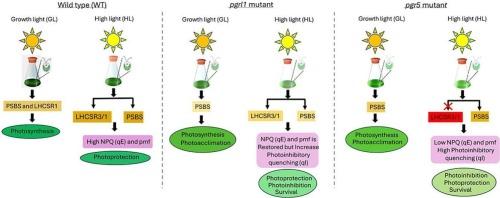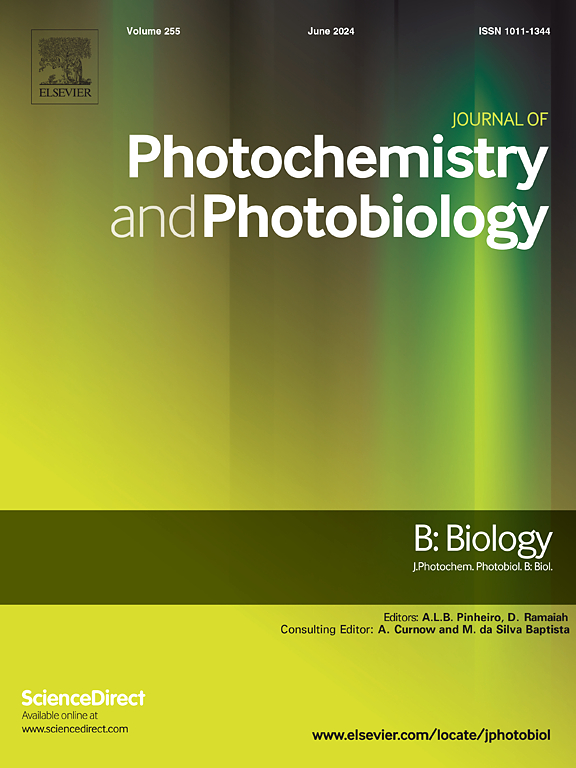LHCSR 和 PSBS 蛋白之间的相互作用为强光下的衣藻 pgr5 突变体提供了光保护。
IF 3.9
2区 生物学
Q2 BIOCHEMISTRY & MOLECULAR BIOLOGY
Journal of photochemistry and photobiology. B, Biology
Pub Date : 2024-11-07
DOI:10.1016/j.jphotobiol.2024.113060
引用次数: 0
摘要
循环电子传递(CET)是一种重要的替代途径,可防止光损伤并帮助产生能量。这一过程依赖于与 CET 相关的质子梯度调节 5(PGR5)和 PGRL1 依赖性途径。在长期强光条件下,这些蛋白质在光系统 I 光化学中的确切作用尚不完全清楚。持续的光适应取决于两个关键机制:质子动力(pmf)的改变和通过非光化学淬灭(NPQ)消散过量光的被强光激活的蛋白质比例的调整。为了探讨这个问题,我们研究了 pgrl1 和 pgr5 突变体,以衡量它们在平衡光化学和光螯合作用方面的作用。这些突变体在强光下表现出生长受抑制、光合效率降低和pmf降低,导致非光化学能量淬灭(qE)减弱。长时间的强光照射减缓了非调控能量损失 Y(NO),而弛豫则通过增加光抑制淬灭(qI)来帮助调节光合作用活性,从而防止光系统进一步受损。pmf的两个成分ΔpH和Δψ之间的精确平衡对于控制光化学和光螯合至关重要,但至今仍难以捉摸。在 pgr5 中,pmf 的减少导致细胞色素 b6f 在强光下的积累、ΔpH 成分的减少以及Δψ成分在光合适应中作用的增加。值得注意的是,采光复合体应激反应蛋白 3(LHCSR3)在 pgrl1 中的表达量减少,而 pgr5 在高光条件下 LHCSR3 和 LHCSR1 均无表达。此外,pgr5 中 PSBS 蛋白积累的持续增加表明,在强光下 LHCSR3 缺失的情况下,光保护作用增强。这项研究为了解 CET 如何调控光保护蛋白 LHCSR 和 PSBS,从而影响衣藻的生存策略提供了重要启示。本文章由计算机程序翻译,如有差异,请以英文原文为准。

The interplay between LHCSR and PSBS proteins provides photoprotection in Chlamydomonas reinhardtii pgr5 mutant under high light
Cyclic electron transport (CET) is a vital alternative route that protects against photodamage and aids in energy production. This process depends on proton gradient regulation 5 (PGR5) and PGRL1-dependent pathways associated with CET. The exact roles of these proteins in photosystem I photochemistry under prolonged high light conditions are not fully understood. Continuous light adaptation hinges on two critical mechanisms: alterations in the proton motive force (pmf) and adjustments in the ratio of proteins activated by high light that dissipate excess light through non-photochemical quenching (NPQ). To explore this, we studied pgrl1 and pgr5 mutants to gauge their roles in balancing photochemistry and photoacclimation. These mutants showed inhibited growth, reduced photosynthetic efficiency, and a lowered pmf, leading to diminished non-photochemical energy quenching (qE) under high light. Prolonged high light exposure slowed down unregulated energy losses Y(NO), and relaxation helped regulate photosynthetic activity by increasing photoinhibitory quenching (qI), thus preventing further damage to the photosystem. The precise balance between the two pmf components, ΔpH and Δψ, is critical for controlling photochemistry and photoacclimation, yet remains elusive. In pgr5 reduced pmf led to an accumulation of cytochrome b6f under high light, and a decrease in the ΔpH component and increased the Δψ component's role in photosynthetic acclimation. Notably, light-harvesting complex stress response protein 3 (LHCSR3) showed decreased expression in pgrl1, whereas pgr5 exhibited no expression of both LHCSR3 and LHCSR1 under high-light conditions. Moreover, continuous increase in PSBS protein accumulation in pgr5 suggests enhanced photoprotection in the absence of LHCSR3 under high light. The study provides significant insights into how CET regulates photoprotective proteins LHCSR and PSBS, influencing Chlamydomonas' survival strategies.
求助全文
通过发布文献求助,成功后即可免费获取论文全文。
去求助
来源期刊
CiteScore
12.10
自引率
1.90%
发文量
161
审稿时长
37 days
期刊介绍:
The Journal of Photochemistry and Photobiology B: Biology provides a forum for the publication of papers relating to the various aspects of photobiology, as well as a means for communication in this multidisciplinary field.
The scope includes:
- Bioluminescence
- Chronobiology
- DNA repair
- Environmental photobiology
- Nanotechnology in photobiology
- Photocarcinogenesis
- Photochemistry of biomolecules
- Photodynamic therapy
- Photomedicine
- Photomorphogenesis
- Photomovement
- Photoreception
- Photosensitization
- Photosynthesis
- Phototechnology
- Spectroscopy of biological systems
- UV and visible radiation effects and vision.

 求助内容:
求助内容: 应助结果提醒方式:
应助结果提醒方式:


